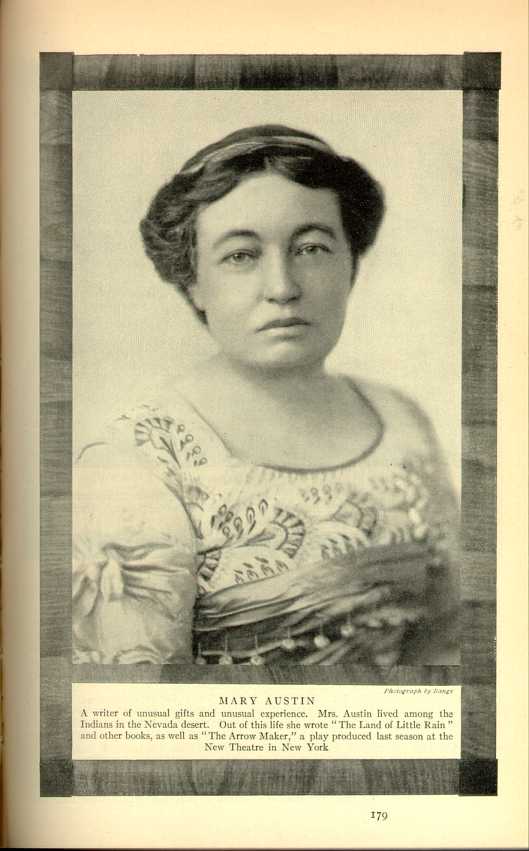| Mary Austin | ||
MARY AUSTIN
OUT in the great Southwest they say that the desert “gets” those who live there long enough, and they illustrate themselves the truth of that saying. They say, but they stay; they cannot come away.
“No reminders will fend men from its trails,” says Mary Austin in her “Lost Borders.” And she thinks the reason is that “there is something incomprehensible to the man-mind in the concurrence of death and beauty. Shall the tender opal mist betray you? the airy depth of mountain blueness; the blazonry of painted, mud-scarred buttes; the far peaks molten with the alpen glow, cooled by the rising of the velvet, violet twilight tide, and the leagues and leagues of stars? As easy for a man to believe that a beautiful woman can be cruel.”
That's the desert. Mary Austin got it. It didn't get her, and she explains that, too.
“Mind you,” she says, “it is men who go mostly into the desert, who love it past all reasonableness, slack their ambitions, cast off old usages, neglect their families because of the pulse of a life laid bare to its thews and sinews. Their women hate the life like the land.”
This they deny out there. I've heard them say that the desert did get Mary Austin; that what she calls the “mark of the land,” is cut in her own soul; and that after London, Paris and New York, she will have to come back. And something she said recently about these “lonely, desert, city places,” points that way. But this may mean no more than that, as she saw the whole world and the fulness thereof in the Mohave, so now she sees the desert and all the emptiness thereof in the town. New York “gets” one, too, in time, especially women.
No matter now how this turns out, however, there is no denial out there that this woman knows and shows the desert. On the contrary, when the tourist steps, eye-sore, parched and disappointed, from his train, the contented inhabitants offer him her books. These tell their tale, and it's the story of a people who feel and who love the romance in the few, commonplace facts of a very charming, but very monotonous life. It's poetry, her prose is; it's the poetry of life, of life lived to-day; conscious, beautiful poetry. That's what gets them out there, and that's what Mary Austin got.
And it is one of the marvels of the desert that she did get it; a marvel with a common-place explanation. She was one of those many little middle Western girls who wanted to write, so she wrote. She was born in Carlinville, Ill., a Methodist center for hogs and corn, and she wrote there. “Rubbish” they called it, and they sometimes called her a liar. But the reason they called her that was because, being brought up (like you and me) not to see, not to hear and especially not to say such things, she saw and she heard and she told marvelous “stories” about such things as happen on the prairie of hogs and corn. In other words, she hit upon the secret of literary success. Her hungry mind seized upon the life about her and she saw and she wrote the romance that is in all life. She is making a novel now of that stuff.
Well, that's how she got the desert. Yearning for the great world, she was taken to California at nineteen by her family, which settled at Tejon Pass, on the edge of the Mohave desert. There she married, and her husband took her deeper in, to Lone Pine. There was work to do, and they did it. Mrs. Austin worked “like an Indian woman,” she says: house-work, gardening, and she taught school. Also she studied and she wrote. There was nothing to write about; that is to say, there was nothing to write about that was like anything that had ever been written. So she wrote what had never been written. She wrote the desert.
“I wrote for the great world outside,” she says, “and I kept in touch with it. There were no papers, no news, no books, no theatre, no music, but—by a sub-sense of some sort, I moved as the world moved.”
Once, as a teacher, she drafted a new plan for teaching which was accepted in California, and, by and by, it developed that this same plan had been thought of and adopted “outside.” She has other marvelous stories to prove her sub-sense. But there's another explanation.
Mary Austin, having nothing else to study, studied the desert, its form, its weather, its lights, its plants. “I saw that the shadow of sage brush was a dark tawny color,” she says, “the rabbit bush was blue. I painted them to make sure.” She rode and tramped about everywhere and she “saw the coyote look up to see where buzzards were going, for a sign of food.” And then there were men and
| Mary Austin | ||
